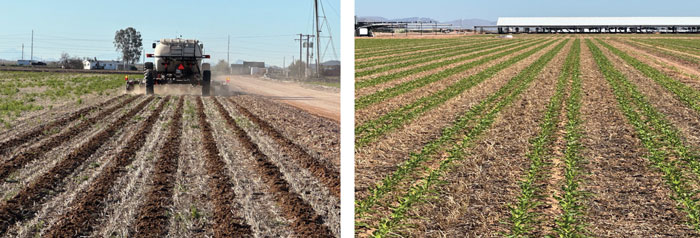Robert Boyle is a self-proclaimed strip-till outlier in Coolidge, Ariz., where his 1,200-acre corn, cotton, alfalfa and dairy operation only gets about 7 inches of rain — if he’s lucky — and it often comes over the course of 2-3 storms.
“I used to be one of those guys who thought strip-till looks good on paper, but won’t work in my soil and environment,” Boyle says. “Orthman came out to my farm one day, ran its 1tRIPr on 100 acres, and I said, ‘Wow, it works.’ Now if a strip-till rig ends up in Arizona, I don’t let it leave. That’s how I also ended up with a SoilWarrior and a Zimmerman.”
Today, Boyle uses all 3 of his toolbars — Orthman, Environmental Tillage Systems (SoilWarrior) and Zimmerman — to strip-till corn and cotton on his irrigated farm, as well as another 4,000 custom acres.
Before switching to strip-till in 2013, Boyle struggled with diminishing corn silage yields and thought the only solution was more tillage and inputs.
“I could apply 500 units of nitrogen, and it wouldn’t matter — my yields still didn’t increase. I was working the ground so much that I was beating it into flour, and the soil wouldn’t take any water,” Boyle recalls. “On top of that, fertilizer costs were rising. I was creating the perfect storm and causing all my own problems.”
Boyle figured he could fix the problems with iron, but eventually realized the best answer was having “as many roots in the ground as I can get, all the time.” He sold his plow and his ripper, and he estimates a total savings of $768 per acre since going all in on strip-till and cover crops.
Strip-Till vs. Conventional: $295 Savings Per Acre
Boyle crunched the numbers and determined his old conventional tillage program was costing him about $440 per acre, broken down as follows:
- Subsoiling 25 inches deep ($75)
- Second subsoiler pass or plow ($75)
- Offset disc to break clods ($40)
- Land Plane to smooth field ($30)
- Laser leveling ($95)
- Finish rip to loosen hard ground ($65)
- Broadcast fertilizer ($15)
- Plant corn/cotton ($45)
“I used to take my alfalfa out in October, and then from October to February, all I did was tillage,” Boyle says. “With strip-till, I can keep the alfalfa in longer and get an additional 3 cuttings. And then in a 2-3-day turnaround, I strip-till in February and plant corn shortly after. We’re getting way more revenue off those acres.”
Boyle estimates his strip-till system costs about $145 per acre, nearly $300 less than the conventional tillage program, broken down as follows:
- Kill alfalfa with Roundup, sprayer pass ($25)
- Strip-till & band fertilizer into strip ($75)
- Plant twin-row corn, 40,000 seeds per acre ($45)
His rotation starts in September with alfalfa. Boyle then interseeds a triticale cover crop mix into the alfalfa in mid-October, and then the triticale is harvested in February ahead of corn, yielding 3-4 tons.
He strip-tills corn in 30-inch twin rows with his 8-row SoilWarrior 2-3 days after triticale harvest. The corn is harvested in mid-July and can be replanted for a second crop to be harvested in November. About 30% of his farm is left fallow in the summer due to local water restrictions.

TWIN ROWS. Robert Boyle strip-tills corn about 2-3 days after triticale harvest in February. The corn is harvested in July and can be replanted for a second crop to be harvested in November. Robert Boyle
“We used to farm 100% of our acres, triple-cropping triticale and corn, and then sorghum and corn,” Boyle says. “With the drought on the Colorado River, water supplies have been curtailed, and we’ve reverted to ground water. We now grow as much winter feed as we can between alfalfa and cover crops. We can get 10-12 cuttings of alfalfa in a year.”
Cotton is planted in April on fields following alfalfa or triticale. Boyle uses his Zimmerman toolbar to strip-till cotton in 38-inch rows in strips that are 8 inches wide and 10 inches deep. The narrow strips help conserve moisture, Boyle says.
Water Conservation: $153 Savings Per Acre
By strip-tilling his corn in 30-inch rows, with 12-inch bands, Boyle calculates he’s only truly farming 40% of his total acres. This allows him to cut his fertilizer costs by 25% without losing yield.
“Why spend money on the other 60%? When you broadcast fertilizer, you’re covering every acre. When you band fertilizer, you’re consolidating it underneath the plant,” he says. “You can use a lot less fertilizer.”
Boyle takes the same approach to his water management and only irrigates 40% of his acres. He keeps the soil between the strips as undisturbed as possible to reduce water penetration (outside the strips) and weed pressure.
“We want the water to go right into the strips and suck it up like a sponge,” Boyle says.
Looking for a new way to increase his water use efficiency, Boyle ran a 360 RAIN autonomous irrigation and nutrient application system for the first time in 2024. With a 60-foot boom, the system applies bands of water — or nutrients — through Y-drop style hoses directly to the base of the plant. He built tram lines in the field for the system to follow.
“It took me a long time to screw up my farm and a long time to fix it…”
360 RAIN made its maiden voyage for Boyle on a strip-tilled corn field that was planted March 1. It made 15 passes, applying 0.5-1.8 inches of water per pass. The corn was then flood irrigated for 3 weeks late in the season to match the crop’s peak water consumption stage. In total, the system delivered 34 inches of water, compared to 60 inches that’s typically used when a field is conventionally flooded, resulting in 43% water savings and $153 savings per acre.
“I think we’ll get increased savings on our second corn crop that’s planted in August because we’ll be going into our cooler months,” Boyle says. “At pollination, it’s not going to be 120 degrees, it’s going to be 80 degrees.”
Boyle is considering buying another 360 RAIN unit for cotton and changing to a concave furrow to funnel water into the root zone.
“We’ll see how that works because I’m kind of afraid of the first irrigation when I flood,” he says. “Am I going to have a runoff issue with the water?
“We also want to start streamlining the fertilizer on corn and cotton through the 360 RAIN unit,” Boyle adds. “We were being conservative with the unit in 2024. The last thing we wanted was a flop the first year with it.”
Cover Crop Mixes: $71 Savings Per Acre
Cover crops are a huge piece to the puzzle for Boyle, who started using them a few years ago when he realized his best corn yields were on fields following alfalfa. His initial goal was to add a legume cover crop between multiple years of corn-on-corn.
“We like oats as forage, hairy vetch and clover for nitrogen fixation and radishes and turnips for ground conditioning, but the forage harvester didn’t like them,” Boyle says. “We have rotary hay rakes, and our fields started looking like Topgolf. We were just beating up the tractor windows with turnips. They’d also come out of the ground with dirt on them, and they’d set off the metal detectors on the choppers. We started using kale as an alternative.”
Boyle plants about 80 pounds of cover crop seed per acre, more than enough to produce as much as 100 units of residual nitrogen (N), saving him an estimated $71 per acre on inputs.
“And some of these things are hard to put a number on, but we’ve definitely seen an improvement in soil health since we started using cover crops,” Boyle says. “We see a deeper-colored green in the corn and it’s 2-feet taller.”
NRCS EQIP Funding: $249 Savings Per Acre
Boyle applies for funding through the NRCS Environmental Quality Incentives Program (EQIP), which helps offset the costs of his strip-till equipment and 360 RAIN unit. He encourages fellow strip-tillers to use his list of NRCS EQIP funding “cheat codes” below:
- Code 340 Multi-Species Cover Crop ($90 per acre)
- Code 328 Conservation Cropping Sequence
- ($28 per acre)
- Code 334 Controlled Traffic Farming ($47 per acre)
- Code 329 Residue & Tillage Management (No-Till) ($15 per acre)
- Code 590 Nutrient Management ($38 per acre)
- Code 376 Field Emissions Reduction ($16 per acre)
- Code 345 Residue & Tillage Management (Strip-Till) ($15 per acre)
- Code 116 Soil Health Management ($2,400 payment)
“If you have a lot of patience, this is a great way to get funding to help pay for a strip-till rig,” Boyle says. “The NRCS person may not know anything about cover crops, but if you tell them ‘Code 340,’ they can start checking if you qualify. I go to my NRCS office with the list of codes and tell them to sign me up. I’m the only guy in Arizona who’s ever gotten the cover crop payment.”
It sometimes takes Boyle up to 2 years to get some of the EQIP funds. But it’s well worth the wait, he says, just like the long-term benefits of strip-till.
“Strip-till works with the right guidance and a little bit of help,” Boyle says. “Give it 3 years. It took me a long time to screw up my farm and a long time to fix it. And don’t be afraid to farm ugly. I don’t mind a few weeds. I don’t mind some stubble sitting out there. I’d rather have that than the picturesque fields of bare ground with no soil structure or biology in it.”







